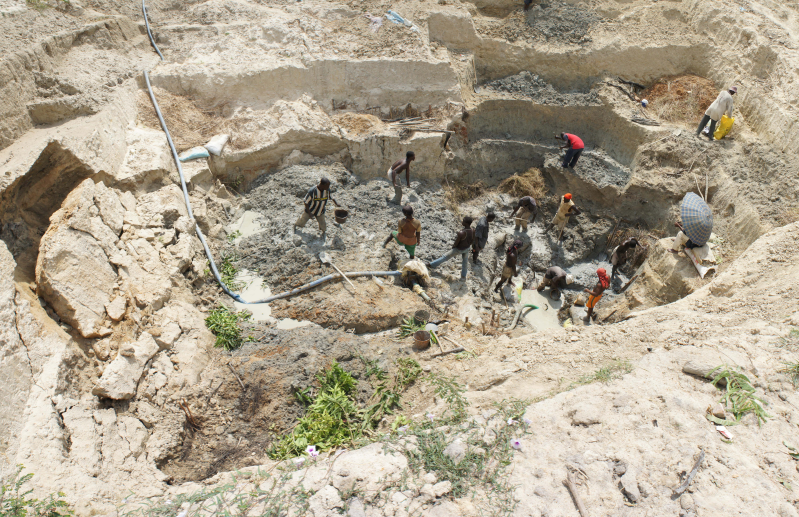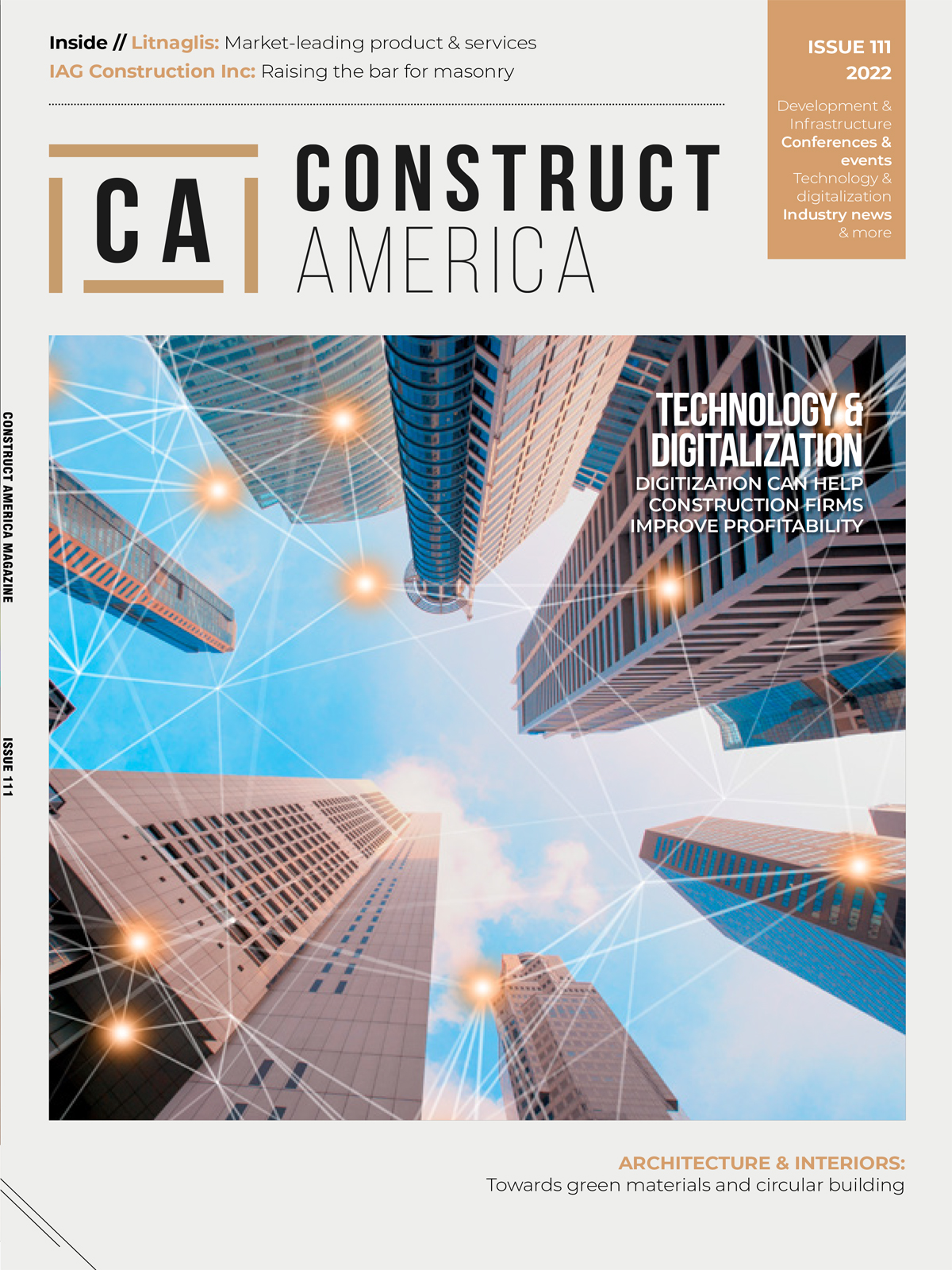USGS calculates realistic production numbers and identifies where illegal activity is taking place.
The concept of conflict diamonds or “blood diamonds” emerged in the late 1990s when it became evident that several violent civil wars in Africa were connected to mining and trading of rough diamonds. In 2006, the U.S. Geological Survey was asked by the U.S. Department of State to help address illegal diamond mining in Africa.
Since then, the USGS has collaborated with several international organizations working to track and monitor illegal mining and armed groups funded by natural resources around the world. USGS scientists help detect where illegal mining is likely taking place and develop realistic production numbers to determine a country’s true capacity for mining and exporting various resources. This knowledge helps identify differences between what can be produced versus what is being exported, and whether miners are crossing borders to illegally mine and sell resources.
Many armed conflicts are financed and sustained by illegally selling or trading natural resources, including gold, tin, tantalum, tungsten, gemstones such as diamonds, rubies and jade and construction materials such as sand and gravel.
Unregulated and Unlicensed Mining
Minerals are frequently mined by artisanal and small-scale miners, who commonly operate in the informal sector, meaning they are not licensed and don’t own the land on which they mine. They often transport and sell resources outside of the legal flow chain in violation of local or national law.
Artisanal and small-scale mining involves individuals or groups of miners using simple tools such as picks and shovels and sometimes larger equipment to dig in river floodplains and sedimentary deposits across large stretches of terrain. Industrial-scale mining occurs at permitted and regulated sites and typically requires heavy infrastructure to extract resources.
The informality and large geographic extent of artisanal and small-scale mining can lead to commodities being mined, sold and purchased through unofficial channels, and potentially financing criminal or terrorist organizations. This can increase the risk of conflict, violence and terrorism within a country and with other nations, including the U.S.

Realistic Production Numbers
“USGS science helps determine the extent and value of mineral production in conflict-prone regions,” said Pete Chirico, associate director of the USGS Florence Bascom Geoscience Center and special advisor to the U.S. Department of State’s Office of Threat Finance Countermeasures. “The USGS conducts field investigations, uses satellite imagery, creates geologic maps and publishes reports to pinpoint resource deposits, estimate mineral quantities and determine production capacity.”
“The ability to use satellite imagery to acquire detailed information on artisanal mining activities is invaluable for researchers and policy makers, as it allows us to evaluate challenging and often difficult-to-access regions that also have associated conflict and safety concerns,” continued Chirico.
USGS scientists also do on-the-ground fieldwork to study the deposits and small-scale mining pits to investigate artisanal and small-scale mining processes and determine the extent and quality of the resources. The researchers also work to understand the viewpoint of the miners themselves and their methods, tools, habits and organization. Scientists conduct interviews with artisanal miners to understand how much is or can be mined over a certain period of time, how they are organized and how frequently they move from site to site.
Informing Decisions on Illegal Activity
USGS has collaborated with the U.S. Department of State, U.S. Agency for International Development, United Nations and other governmental and nongovernmental organizations working to address conflict mining.
For example, USGS information assists the U.S. Department of State in implementing the Clean Diamond Trade Act, which prohibits import or export of rough diamonds unless accompanied by a Kimberley Process certificate confirming that it is not a conflict diamond. The Kimberley Process is an international initiative to increase transparency and oversight in the diamond industry to eliminate trade in conflict diamonds.
“The USGS has been instrumental in supporting a fact-based approach to the Kimberley Process work on eliminating conflict stones from the rough diamond supply chain,” said George Cajati, a foreign affairs officer at the U.S. Department of State, and the interim U.S. representative to the Kimberley Process. “USGS has provided unsurpassed scientific analysis and expertise to inform U.S. policy in this high-profile international forum and earned the respect of international partners in the process.”
Examples of Research and Impact
Guyana
Illegal mining and export of gold are concerns for the country of Guyana. At the government of Guyana’s request, the USGS and the U.S. Embassy began a project in 2021 to help document nationwide artisanal and small-scale gold mining. Work is being done in cooperation with Guyana’s Ministry of Natural Resources. The effort includes using satellite imagery to identify mining sites and associated deforestation. Identifying unpermitted mining locations can also help the government address mercury contamination, as mercury is often used in the gold mining process but can pollute the environment and impact human health.
“USGS expertise is helping our embassy achieve three priority goals, which are to encourage good governance, enhance security and promote prosperity,” said Sarah-Ann Lynch, ambassador for the U.S. Embassy in Guyana. “We are working in partnership with the government of Guyana, helping improve their regulatory oversight and law enforcement for the artisanal mining sector.”
Central African Republic
In 2013, a civil war erupted in the Central African Republic that was heavily fueled by the rough diamond trade. The U.S. Department of State requested that the USGS conduct an assessment to help monitor mining activity and diamond exports. In 2018, USGS scientists calculated that more than 330,000 carats of diamonds are mined annually and more than 80 percent are illegally exported or smuggled from territory not controlled by the Central African Republic government. The USGS has ongoing work continuing to help verify which zones are deemed compliant and noncompliant according to Kimberley Process requirements acknowledged by the U.N. This information is currently being used by the U.N., participants in the Kimberley Process and the U.S. government to assist in decision-making related to sanctions on diamond exports.
Guinea
From 2008 to 2010, reported diamond exports from Guinea increased 300% from a range of 300,000 to 400,000 carats to more than 1.2 million carats per year. As part of the Kimberley Process’ examination into the anomaly, the USGS was asked to help assess the country’s diamond resources and production potential. The USGS concluded that production capacity was approximately 400,000 carats per year. Using this information, investigations by a civil society “watchdog” organization revealed the large discrepancy in reported exports was due to hundreds of thousands of carats of illegally smuggled diamonds from Zimbabwe being exported as Guinean diamonds.
Côte d’Ivoire
Following a civil war in Côte d’Ivoire in 2002 and an embargo placed on diamond exports in 2005, the U.N. requested that the USGS assist in developing a resource assessment in the country. USGS scientists investigated diamond production potential in the north of the country, which was under the control of rebel forces. The assessment provided to the U.N. and participants in the Kimberley Process outlined the yearly diamond production in Côte d’Ivoire and the financial resources that the rebel forces were gaining from mining those deposits during that time.
Collaboration and Training
The USGS regularly provides training to foreign governments, including collaborating with their ministry of mines, geological surveys and civil society organizations, ultimately enhancing their ability to assess and regulate resources themselves. Training has been provided on remote sensing and mapping techniques, artisanal miner community surveys, artisanal mine site evaluation and geologic field work methods to assess deposit potential.
The USGS also assists programs aimed at formalizing and legalizing the artisanal and small-scale mining sector such as those implemented by USAID. The USGS identifies which areas are best for this type of mining, and foreign governments can then establish easier processes for miners to acquire licenses as well as land and resource rights in those areas. That way miners are monitored and provided guidance and revenues benefit the nation where the resources are mined.
Research in Africa, Asia and South America
USGS scientists have conducted research related to conflict mining globally, including countries in Africa, South Asia and South America. USGS research on artisanal and small-scale mining in Africa has focused on diamond mining in the Central African Republic, Mali, Guinea, Côte d’Ivoire, Ghana and Zimbabwe; and gold mining in Côte d’Ivoire, Mali and the Democratic Republic of the Congo. This year, the USGS began a project assessing artisanal mining of cobalt in the Democratic Republic of the Congo. Cobalt is used in the production of electric vehicle batteries.
USGS scientists have also studied the mining of rubies in Myanmar (Burma), Asia, and the use of mercury in small-scale gold mining in Guyana, South America. The USGS recently completed a project in Afghanistan, funded by USAID, in which scientists mapped and monitored informal mining of emeralds, rubies, gold, construction materials and other minerals.
Learn More
Visit the USGS project website to learn more about science on conflict mining.
Construct America Magazine | The Home of Construction Industry News




















